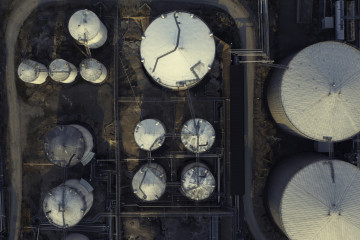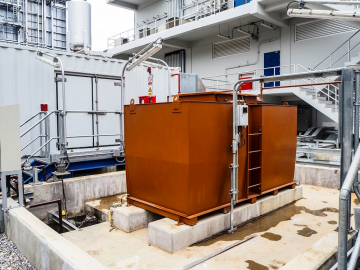Facilities that possess aboveground oil storage capacities exceeding specified thresholds, along with the potential for oil discharge to navigable waters or shorelines, are required by federal regulations to develop and implement a Spill Prevention, Control, and Countermeasure (SPCC) Plan.
While most facilities are aware of the need to include bulk oil storage containers in their SPCC plans, the inclusion of oil-filled equipment is often overlooked.
In this blog post, we will explore the importance of considering oil-filled equipment in your SPCC plan and shed light on its applicability.
What is Oil-Filled Equipment?
Oil-filled equipment is defined under 40 CFR 112.2 as equipment that includes an oil storage container (or multiple containers) in which the oil is present solely to support the function of the apparatus or the device. If the equipment has containers/reservoirs which contain oil and have a capacity of 55 gallons or greater, that equipment must be included in the SPCC plan.
Containment
According to the SPCC Guidance for Regional Inspectors, the definition of bulk storage container in §112.2 specifically excludes oil-filled electrical, operating, and manufacturing equipment (“oil-filled equipment”). Therefore, oil-filled equipment is not subject to the bulk storage container requirements in §§112.8(c), 112.9(c), and 112.12(c). However, oil-filled equipment must meet the general requirements of §112.7.
Oil-filled equipment must be provided with general secondary containment for the most likely spill scenario (§112.7) which can be defined as drips or leaks that can occur from equipment under normal operation. This could be a pint to a few gallons depending upon the rate and duration of the leak. General containment is not intended to contain the entire capacity of the reservoir.
Inspections
While the integrity testing requirements of §§112.8(c)(6) and 112.12(c)(6) are only applicable to bulk storage containers, EPA believes it is good engineering practice to have some form of visual inspection or monitoring for this oil-filled equipment to prevent discharges as described in §112.1(b) - see SPCC GUIDANCE FOR REGIONAL INSPECTORS, August 28, 2013.
Typically, it is recommended to inspect and maintain oil-filled equipment according to manufacturer recommendations. Oil-filled equipment should be included as part of a routine walk-around inspection of the facility.
The EPA has grouped oil-filled equipment into three categories:
- Operational
- Electrical
- Manufacturing
The following provides descriptions and examples of these types of oil-filled equipment which you might find at your facility.
Operational/Mechanical
Oil-filled operational equipment means equipment that includes an oil storage container (or multiple containers) in which the oil is present solely to support the function of the apparatus or the device – see 40 CFR 112.2.
THINK RESERVOIR! Does the equipment have an oil reservoir? Is the reservoir 55 gallons or greater in capacity?
Examples of Oil-Filled Operational Equipment include:
Elevators – These reservoirs are usually located in equipment rooms which provide sufficient general secondary containment by concrete floor and walls.
Compressors – Oil lubrication and oil coolant reservoirs for large compressors.
Compactors – Large trash, box, or used automotive filter crushers can have hydraulic oil reservoirs.
Machining Equipment – Metal fabrication, manufacturing, and repair facilities can have equipment such as shears, brake presses, drills, or benders with oil reservoirs for operation or lubrication.
Generator - Working Oil Capacity - Typically, there are two oil containers associated with a generator:
- Fuel tank (bulk container)
- Oil reservoir to lubricate the engine
- The oil reservoir/crankcase on some very large generators can exceed 55 gallons in capacity and be subject to SPCC requirements for OFE.
Wind Turbines - can have gearbox oil volumes that exceed 55 gallons in capacity and be subject to SPCC requirements for oil-filled operational equipment. Containment is typically addressed with a contingency plan or equipment maintenance program for qualifying equipment.
Electrical
Electrical equipment such as transformers, circuit breakers, and switches can contain oil (mineral or dielectric) for cooling and electrical insulation. If the electrical equipment is large enough, the oil capacity can reach 55 gallons or more causing the equipment to be regulated as oil-filled operational equipment in your SPCC plan.
Transformers - are the most common electrical oil-filled equipment and can be either facility-owned or public utility owned. If they are facility owned, then the transformers must be included in the SPCC plan as oil-filled operational equipment and general containment must be provided.
Manufacturing/Process
Oil-filled manufacturing equipment stores oil only as an ancillary element of performing a mechanical or chemical operation to create or modify an intermediate or finished product. - see SPCC GUIDANCE FOR REGIONAL INSPECTORS, August 28, 2013.
THINK PROCESS OR CHANGE! The oil product flows through the equipment or is changed within the equipment.
Examples of Oil-Filled Operational Equipment include:
- Mixing Tanks,
- Reaction Vessels,
- Phase Separators,
- Oil Heaters,
- Dryers,
- Knockouts, and
- Vapor Recovery vessels.
By understanding the significance of oil-filled equipment and its inclusion in your SPCC plan, you can ensure compliance with federal regulations and effectively mitigate the risk of oil spills. Remember to consider operational, electrical, and mechanical equipment at your facility.
Also, remember to conduct regular inspections and maintenance according to manufacturer recommendations. By doing so, you can enhance the overall safety and environmental stewardship of your facility.
Do you have questions about oil-filled equipment and your SPCC plan? Antea Group is here to help.
To get answers to all your questions and for guidance in building your SPCC plan, reach out to our SPCC Plan Experts today!
Want more news and insights like this?
Sign up for our monthly e-newsletter, The New Leaf. Our goal is to keep you updated, educated, and even a bit entertained as it relates to all things EHS and sustainability.
Have any questions?
Contact us to discuss your environment, health, safety, and sustainability needs today.






